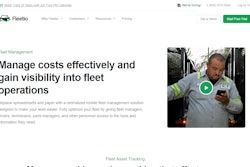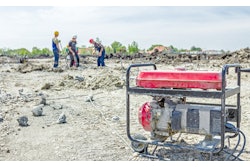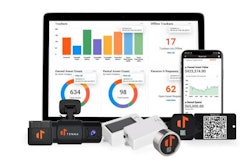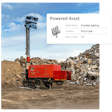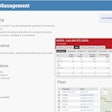
While competitors like Samsara and HCSS Equipment360 are single-tenant software products designed at first for on-premise use, Fleetio and Tenna were born in the cloud, and offer affordable and powerful GPS-enabled fleet management software as multi-tenant software-as-a-service.
Multi-tenant SaaS enables a software vendor like Fleetio to run a single instance of their software in the cloud, which all customers access simultaneously. This makes it faster and more affordable to develop, update and manage software in the cloud, and is frankly a more lucrative business model for the software vendor than single-tenant cloud software where each customer has its own instance.
The strong multi-tenant SaaS business case, the growing demand for digitization in construction mean companies like Fleetio can attract venture capital and grow rapidly, serving more contractors and other businesses and adding features and functionality to their product. The company has pulled in a total of $25 million in venture capital including a $21 million series B round in November of 2020. Venture-funded businesses tend to spend that money not on operations, but in research and development and scaling up the operation. At the time of my debriefing call with Fleetio, they had just tripled the headcount dedicated to taking the product to market and at least doubled research and development headcount.
The addressable market in construction is significant given that Fleetio is financially viable and attractive to companies running fleets as small as five pieces of equipment, and can also scale to tens of thousands of vehicles.
For construction companies, Fleetio delivers tools to capture operating data from telematics units on each piece of equipment, extending that with functionality for inspections, maintenance workflows and asset utilization analytics. Using this data, a contractor can confidently project equipment costs before bidding on a job. Different Fleetio modules will be used by executives to determine projected and actual costs, fleet managers to master asset availability and assignments and maintenance shop workers completing work orders.
FUNCTIONAL DEPTH AND BREADTH
Fleetio offers both the proactive tools for preventive, calendar-based and even duty cycle-based maintenance and tools for reactive maintenance, which is triggered by a failure, trouble code or symptom. There are some neat, streamlined features to build out maintenance schedules for new equipment added to the application that imports recommended maintenance intervals and parts inventories from the original equipment manufacturer (OEM). The end result is a very robust data feed for each piece of equipment that drives a full parts and inventory management module for consumables. There is some sophisticated warehouse management power here, with the ability to track quantities of each part in multiple locations and cycle counting. All of the individuals inside and outside the company that use, service and support the piece of equipment are entered in a customer relationship management (CRM)-like tool so they can receive updates, tags regarding equipment use, schedule reminders and notifications when important certifications are due.
Underpinning Fleetio is a robust document management tool that shares asset-related documents across the various parts of the application across multiple equipment-related workflows. Workflow tasks can be assigned to an individual or to technicians at a specific location either inside the organization or outside of it, with external maintenance contractors.
While Fleetio maintenance functionality was not at the time of the debriefing harvesting sensor data to trigger condition-based maintenance work orders, there is a forecasting model built in, based on frequency of movement and engine hours. Fleetio can then optimize the service schedule based on how the asset is being used. Fleetio’s API can and does however collect data from any gauges or sensors on the equipment, but work continues to turn that data into transactions that initiate actions in Fleetio, and these could include work orders and even spares and repairs parts requisitioning.
Data is also surfaced on who last had equipment, which can combat theft of tools, and help locate equipment that otherwise could be replaced. There are lighter weight repair processes in Fleetio for repair of smaller equipment, and one decision users need to come to terms with in the product is whether to categorize different items as vehicles or equipment—based on maintenance program requirements and complexity.
FLEETIO TECH STACK
Like many other construction software vendors, Fleetio realizes a great deal of usage will take place on mobile devices, so they architect native interfaces for both Android and iOS. This enables better use of handset features—including geolocation and cameras, and makes it easier for Fleetio to make the mobile interfaces function on their own if a data connection is lost. Reading near field communication (NFC) tags, a method of tracking equipment objects and tools that is gaining popularity, is also easier with a native interface as Fleetio offers.
Since Fleetio delivers its product through multi-tenant SaaS, it can update the codeline regularly, with major functional changes being driven by an annual customer survey, and then beta tested by select customers. But incremental and security fixes can be pushed out regularly via Horoku, a development platform Fleetio uses to create the front end software users experience and back-end applications on Amazon Web Services, where Fleetio is provisioned across multiple zones for redundancy.
Because data on equipment usage and maintenance are consolidated in a single application, Fleetio can surface data and analytics through dashboards, with key metrics being cost per mile, cost per utilization unit and value trends over time. This in turn drives decision-making tools, including a replacement analysis calculator that supports fix-or-replace decisions.
Fleetio offers a number of standard integrations with other applications, and also makes available an application programming interface (API) that surfaces its RESTful API so end users can, with limited or no assistance, create their own integrations with other products that have their own APIs.
PRICING AND MARKUP
Because Fleetio will be a fit for fleets as small as five vehicles, the addressable market is huge—something not lost on investors who see the tremendous potential of SaaS-driven fleet management software. Fleetio will often go to market with its integration partners, ranging from GPS and telematics vendors like Samsara, Geotab, Verizon Connect and others to business applications like Oracle Netsuite.
But while the software subscription cost scales for Fleetio based on fleet size, they negotiate a little so cost does not rise in direct proportion with the size of a large fleet. The goal according to contacts within Fleetio is for the software to drive more and more return on investment (ROI) as a customer scales up across more vehicles, more equipment and more functionality.
There is some additional cost for implementation and training, and services packaged during this ramp-up are typically not more than $1,000, with custom service levels for an enterprise-size fleet. Ongoing customer support is free, and larger accounts north of 25 vehicles may get a customer success manager baked into the subscription cost.
With new equipment being harder to come by due to supply chain constraints, good information and processes to maximize asset availability will be important for contractors who need to know they have the equipment capacity to take on new projects. This alone, apart from savings on maintenance and theft prevention, may enable a contractor to cost-justify the expenditure on GPS-enabled fleet management technology.
BOTTOM LINE: In selecting construction technology vendors, you want to pick a winner that is growing, and Fleetio qualifies on this front. It has a sustainable business model and the resources to continue to add value to the product and scale its ability to deliver as its customer base grows. Fleetio is not specific to the construction industry though, so those shopping for a fleet management solution may want to inquire about product roadmap items specific to construction, and determine what hardware and GPS units will stand up to the rigors of heavy OEM vehicles and equipment that will be used hard in rugged environments. Contractors that also run over-the-road vehicles may find Fleetio the best fit, and the company has traditionally done well among builders, specialty contractors, infrastructure and road building, pipeline contractors and oilfield contractors.
